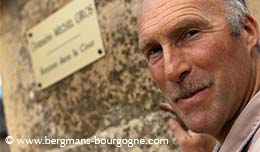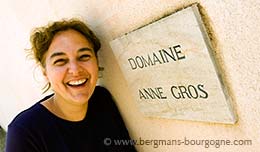
t all started with a horse. And then another one. Caroline and Thibaut Pariset at Domaine de l’Aubraine rode in to the wine world on a Comtois horse and set up shop in the northern Mâconnais.
– We are quite unusual in that respect, says Thibaut Pariset. Our path over the past 20 years has been a different one. Originally I was a forester and my wife worked with horses.
The place is Saint-Gengoux-de-Scissé, a village in the northern Mâconnais with 600 inhabitants. The landscape is not as dramatic as further south. The slopes are gentle and the vineyards not as many.
– Domaine de l’Aubraine is small, says Caroline Pariset. We have five hectares. We started in 2019 and had our first harvest that year. At the time we had 3.06 hectares, but only 2.10 hectares that produced grapes. We hadn’t finished planting the other vineyards. 2024 was the first year we vinified grapes from all the vineyards.
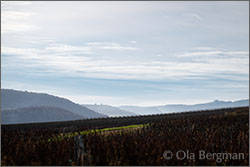 Chardonnay is the main grape variety here. There is a bit of pinot noir at Domaine de l’Aubraine, but it only covers 0.23 hectare. The chardonnay vines are all within the Mâcon-Lugny appellation, but the Parisets have decided to use the broader Mâcon-Villages appellation on the labels.
Chardonnay is the main grape variety here. There is a bit of pinot noir at Domaine de l’Aubraine, but it only covers 0.23 hectare. The chardonnay vines are all within the Mâcon-Lugny appellation, but the Parisets have decided to use the broader Mâcon-Villages appellation on the labels.
– People around here associate the Mâcon-Lugny name with the cooperative, La Cave de Lugny, explains Thibaut Pariset. Apart from the cooperative there aren’t that many bottlings of Mâcon-Lugny, so they basically have a monopoly there.
 – We want to focus on our wines and the individual plots, continues Caroline Pariset. That is more important. The northern Mâconnais is not very well-known. But you still have different parcels with different characters here. Our young vines are where it is cooler and a bit humid. Our old vines are facing straight east and are mid slope. Not the same soil and exposure.
– We want to focus on our wines and the individual plots, continues Caroline Pariset. That is more important. The northern Mâconnais is not very well-known. But you still have different parcels with different characters here. Our young vines are where it is cooler and a bit humid. Our old vines are facing straight east and are mid slope. Not the same soil and exposure.
Neither Caroline nor Thibaut come from a winemaking family. Thibaut’s mother was a teacher and his father was a draughtsman in the construction industry, while Caroline’s parents were in the restaurant industry.
– At one point I stopped working with horses, because I didn’t want to be an instructor or to work at a riding school. I wanted to work outdoors. I got a job at the supermarket instead. At the same time I worked in the vineyards and the winegrower kept asking me if I could use my horse and plough his vineyards. But I didn’t have the knowledge. I didn’t have the experience.
 Eventually she gave in and got the required training for working with horses in the vineyards. At about same time her husband stopped working in the forest after a sporting accident. They bought another horse in 2013 and by the time Caroline had finished her training they already had clients.
Eventually she gave in and got the required training for working with horses in the vineyards. At about same time her husband stopped working in the forest after a sporting accident. They bought another horse in 2013 and by the time Caroline had finished her training they already had clients.
– We worked in the vineyards all across the Mâconnais with our horses, says Caroline Pariset. Today we only have one client left, Julien Guillot at Clos des Vignes du Maynes. Our own domaine takes all our time now.
– Also, the periods for work has become very short, adds Thibaut Pariset. Ten years ago we had ten days to work from the south of the Mâconnais to the north. Today the climate has changed and everything has to be done at the same time. And that is not possible.
– Making wine wasn’t the goal initially, says Caroline Pariset. We wanted to start with the domaine and sell grapes. We wanted to be organic from the start.
The idea was to grow slowly by self-financing. But then COVID-19 hit and they were forced to start making wine earlier than planned. They bought second-hand tanks and a press. The equipment was a bit outdated and the buildings were not ready. The winery still had a beaten earth floor downstairs. In the end they managed to get things working and 2020 saw them producing 5000 bottles of wine.
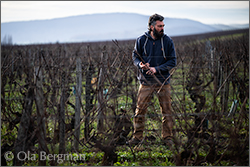 The following year weather conditions wiped out the whole crop, but in 2022 they were back with 2500 bottles and in 2023 with 17 000 bottles.
The following year weather conditions wiped out the whole crop, but in 2022 they were back with 2500 bottles and in 2023 with 17 000 bottles.
The domaine takes its name from the lieu-dit En l’Aubraine, which is also the main cuvée and monopole of the domaine. This makes up a large part of the domaine’s surface area – 2.10 hectares.
– It consists of six parcels, planted on six different occasions, says Thibaut Pariset. The oldest was planted in 2014, the youngest in 2020. There is chalky limestone, very white in colour, with marly soil. You have fossils like oysters, gastropods etc. It is facing west and south. Rainy years can be difficult, because the marl retains the water. Sunny years produce wines with lots of freshness.
– These are our young vines, says Caroline Pariset. Élevage 100 per cent in stainless steel tanks, aged on its fine lees.
 The vines for the Sur le Four are considerably older. Planted mid-slope in 1987, 1988 and 1989 they produce a wine different in character from the En l’Aubraine, which is only 200-300 away.
The vines for the Sur le Four are considerably older. Planted mid-slope in 1987, 1988 and 1989 they produce a wine different in character from the En l’Aubraine, which is only 200-300 away.
– For the Sur le Four we use 50 per cent barrels and 50 per cent stainless steel tanks, says Caroline Pariset. We use demi-muids, 450 litre barrels, which are six to 20 years old. The parcel is facing straight east. It is not very stony. You have some limestone. The soil is reddish with some manganese. The difference in exposure and soil produce very different aromas.
– Sur le Four is mineral at the top of the slope and has more of freshness at the bottom, says Thibaut Pariset. It’s a parcel which is a bit difficult to vinify. That’s why we use both barrels and tanks.
You’ll find the pinot noir of Domaine de l’Aubraine on the same slope as Sur le Four. This is a small parcel they took on in 2023 with vines planted in 1967.
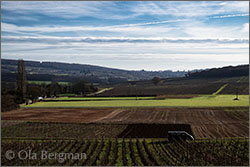 – There is clay and limestone, silty soil, says Thibaut Pariset. You have greyish soil with less manganese. It is more stony, with fossiles. It is is not very deep.
– There is clay and limestone, silty soil, says Thibaut Pariset. You have greyish soil with less manganese. It is more stony, with fossiles. It is is not very deep.
The third Mâcon-Villages of the domaine is the Vigne de Bassy. Bassy is a hamlet, immediately south of Saint-Gengoux-de-Scissé, and also where you’ll find all the vineyards of the domaine.
– It’s a blend of Sur le Four and En l’Aubraine, 30 per cent and 70 per cent respectively. Élevage is 100 per cent in barrels. We mainly work with old barrels. We just add a new one every now and then. But that is less than one new per year.
MMXXIII, which in terms of appellation is a Vin de France, is still very much of a prototype. It is a macerated chardonnay, where the Roman numerals on the label give you the vintage, among other things.
– It is made the old-fashioned way, says Thibaut Pariset. In 2023 it was made without sulphite. M may stand for maceration and X for Project X. It is produced like our pinot noir in terms of maceration, punching down and pumping over. Élevage 50 per cent in a barrel then 50 per cent in a fiberglass tank.
– It is 100 per cent natural, says Caroline Pariset. We use 100 per cent whole bunches. Maceration lasts for 20 days. The wine has not been fined or filtered.
© 2025 Ola Bergman










